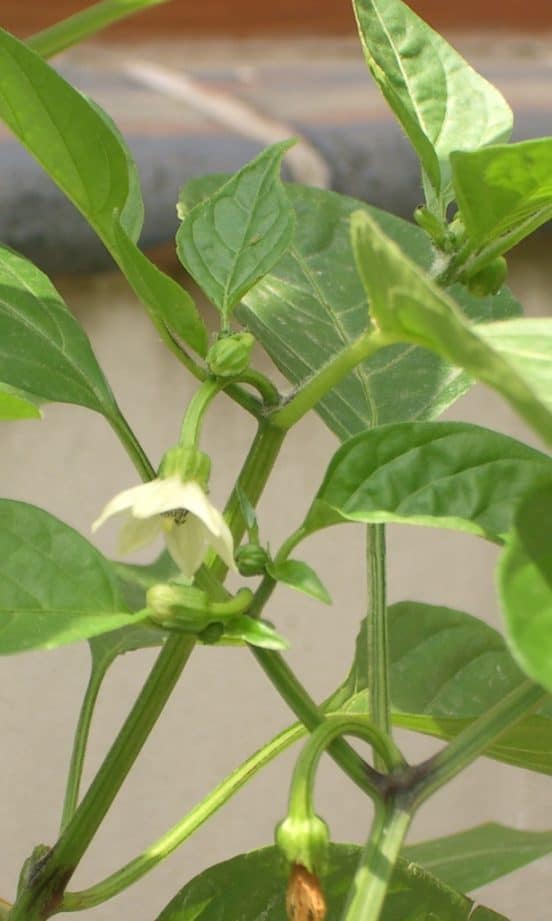Botanically, the classification of plants follows the format of genus, species, and – if relevant – variety/subspecies.
In the genus Capsicum, which comprises the various kinds of chile and bell peppers (chilli, paprika, etc.), there are some 30 species. Five species are counted as having been domesticated and transformed into the immense diversity of chile peppers grown around the world.
Horticulturally, there are further classifications, most notably according to pod type and by origin.
Varieties are less common with the capsicums than land races (which exhibit a wider range of traits). – Oftentimes, those well-known names of “varieties” like Jalapeño are actually pod types!
Capsicum annuum L.
The highest diversity of shapes, the largest number of well-known chiles and the most-sold chiles: all that is to be found with the species C. annuum.
The (pod type) of the bell pepper – the chile used as a vegetable, sold in supermarkets around the world – belongs to this species. Many of the small and very pungent pequin / bird’s eye peppers and piri-piri are or may be C. annuum. The pods which can be nearly white, green, violet or nearly black when unripe ripen to yellow, or orange, or red, or brown, or brownish-black (some even to violet).
Recognizing this species is easiest by a process of elimination: The other species have some typical traits, the one species not showing those traits should be C. annuum.
C. annuum is also the chile pepper which was spread furthest around the world: wherever chile peppers are grown, there will (also) be C. annuum.
Capsicum frutescens L.
The fruits of this species show little variation among different types; but it is typical that the stem grows straight up, with a sudden curve just before the flower head. The pods, again, typically grow vertically – straight up.
C. frutescens bushes, producing lots of pods, showing them above their foliage, often look very nice, rather similar to the “ornamental” type of C. annuum. It is typical, however, that the flowers have more of a greenish tint (though that sometimes seems to get lost), and a pedicel which is cylindrical, staying the same width throughout its length and constricting the base of the fruit.
Similar C. annuum, in contrast, have white flowers (and plants with flowers looking rather like C. frutescens‘ but with violet petals are also, usually, seen as belonging to C. annuum) and a pedicel which follows the shape of the fruit (expanding outwards or, if the pod is really big, flaring outward).
Tabasco “pepper” is sure to be the best known representative of C. frutescens (though mainly, not as a chile pepper but as the pepper sauce). Some C. frutescens can be found around the world, among them also ones with yellow pods.
Capsicum chinense Jacqu.
Habanero, a Caribbean/Mesoamerican representative of C. chinense, is the paragon of this species, its name nearly a synonym. This type is also getting to be one of the best-known chile peppers, not least because the world’s most pungent chile peppers are C. chinense.
Hoever, there are also very small, rather Chiltepin-like pods (“Charapita”), types with longer and more pointed shapes than the rather rotund Habaneros, and there are not only very pungent, but also (nearly) non-pungent C. chinense.
The flowers are quite similar to those of C. frutescens L., but usually there are a few flowers per knot. The very best way to recognize C. chinense, however, is by smelling its fruits: their tropical-fruity aroma is characteristic and easily recognizable.
Due to their particular flavor, these chile peppers are essential ingredients for some recipes and cannot be replaced without altering the dish’s flavor completely. On the other hand, using a C. chinense instead of a more “normal” chile pepper of another species is absolutely not advisable.
Capsicum baccatum (Willd.) Eshbaugh
The ají of South America, that’s C. baccatum.
(Except when it’s not: ají is also used as general word for “chile pepper.” Ají dulce, for example, is C. chinense – one of the non-pungent ones.)
Their flowers make this species easily recognizable: uniquely among the cultivated species, they have a greenish or straw-colored spot at the base of their petals.
The pods are of medium to high pungency, with a note of berries.
Cultivation tends to be a little problematic because the plants tend to become very tall with long and arching branches, lose many of their flowers without setting fruit, and take a long time until the fruits ripen (with them reaching their final size about a month before they start to change color and really finish ripening). When they grow well and set fruit – and that happens rather more often than there are failures – they produce very well.
Capsicum pubescens Ruiz & Pav.
C. pubescens has been spread the least: Its home are the South American Andes (where it is known as Rocoto), and it is (by now?) to be found in the Mexican highlands as well (named Manzano or Canario because of and depending on their shape and color, respectively).
The plants are obviously rather hairy (the species designator pubescens comes from this), have violet flowers (of different colorations, from light to dark, between different types) and, uniquely among the chile peppers, they have black seeds.
The pods ripen to either red or yellow, stay relatively small but get rather heavy (i.e., are very juicy and thick-walled) and develop a peculiar, strong pungency.
Like C. baccatum, C. pubescens grows very nicely, but tends to produce rather badly unless some – not really well-known – conditions are met (it may be that they need a noticeable difference between day and night temperatures, it may be something else). The pods of this species also take rather long to grow to their full size, and a lot longer to ripen.





Leave a Reply
You must be logged in to post a comment.